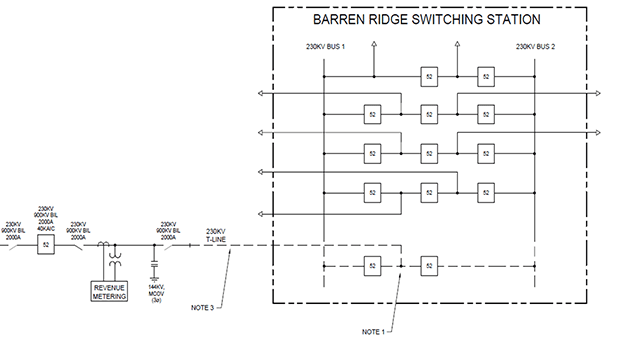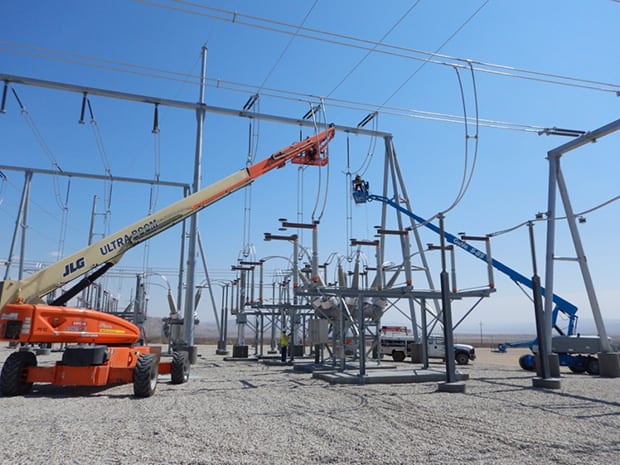California’s Largest Battery Storage Installation to Be Installed in Mojave Desert
Credit to Author: Aaron Larson| Date: Wed, 11 Sep 2019 09:09:53 +0000
The post California’s Largest Battery Storage Installation to Be Installed in Mojave Desert appeared first on POWER Magazine.
On May 16, 2019, the Los Angeles Department of Water and Power (LADWP) and Glendale Water and Power, through the Southern California Public Power Authority (SCPPA), received SCPPA’s approval on agreements with 8minute Solar Energy (8mSE) for the installation of a 300-MW/1,200-MWh battery energy storage system (BESS) located at 8mSE’s Eland Solar and Storage Center. The LADWP Board of Commissioners approved the plan on Sept. 10.
The BESS will be co-located with a 400-MW solar PV plant (PV Plant), which will deliver energy across a 5-mile gen-tie to LADWP’s Barren Ridge Switching Station in the Mojave Desert (Figure 1). The agreements were formalized as power purchase agreements (PPAs) with a 25-year term.
 |
| 1. Barren Ridge Switching Station. Courtesy: LADWP |
 |
| 2. One-line diagram of the Barren Ridge Switching Station. Courtesy: LADWP |
Each PPA nominally stipulates a 100-MW/400-MWh BESS, for a total size of 200-MW/800-MWh, but LADWP intends to exercise its option under the PPA to expand the BESS to the larger size of 150-MW/600-MWh, for a total size of 300-MW/1,200-MWh. Each BESS and PV Plant (Project) is expected to reach commercial operation no later than December 2023. The PV Plant will be built in two phases, with Eland 1 and Eland 2 each having 200 MW of PV and 600 MWh of BESS. Figure 3 shows the interconnection of Eland Solar and Storage Center with the Barren Ridge Switching Station.
 |
| 3. Eland 1 one-line diagram. Courtesy: LADWP |
In order to accommodate the Project, the Barren Ridge Switching Station will need to be expanded with two new busses. In addition, a +200-MVAR/–100-MAVR static VAR compensator (SVC) will be installed at the Barren Ridge Switching Station to supply requisite VAR support and stiffen the newly commissioned Barren Ridge-Rinaldi Transmission Line (BRRTL) receiving the Project energy. The new 63-mile 230-kV, double-circuit BRRTL was completed in 2016 at a cost of approximately $240 million, primarily to enable the Barren Ridge Substation to serve as a hub for renewable energy. Figure 4 shows construction of the BRRTL, while Figure 5 shows on-going upgrades to the Barren Ridge Substation.
 |
| 4. Construction of the Barren Ridge-Rinaldi Transmission Line. Courtesy: LADWP |
 |
| 5. Upgrades to the Barren Ridge Switching Station. Courtesy: LADWP |
The BESS installation near LADWP’s Barren Ridge renewable hub will better position LADWP to meet its aggressive Renewable Portfolio Standard goals of 55% by 2025, 80% by 2036, and 100% carbon neutral by 2045. Renewable generation, such as solar and wind, is heavily weather dependent and will vary over time, often making it difficult to schedule and count on with a high level of certainty. New technologies, including energy storage, advanced inverter functions, and enhanced monitoring and controls, potentially have the capability to bridge the gap between variable renewable and conventional generation.
The objectives of the BESS installation are multifold and include energy arbitrage to help address growing duck curve concerns. By shifting the energy from the daytime peak, LADWP can avoid the negative node locational pricing that some local balancing authorities are forced to offer because they are so flush with solar energy. Another benefit of the BESS is the ability to smooth the volatile renewable energy received at the Barren Ridge Renewable Hub, and provide peak shaving, firming, and shaping. This provides some of the desirable characteristics of a dispatchable peaking source from renewable resources.
The BESS will also provide operational expertise for maximizing BESS assets in grid operations. In particular, it will quantify storage benefits, improve operating practices and flexibility, and lead to more accurate cost/benefit models for storage and renewables. As more experience is garnered, and historian data analyzed, the full benefits of this versatile asset can be integrated into grid operations.
Using controls software, one-minute-resolution PV prediction, and curtailment without energy storage, the BESS should be able to control the solar ramp, up and down, to less than 20% of alternating current nameplate power rating per minute. Ideally, the demonstration of this ability should occur during days with cloud cover on the associated solar plant, whose ramping will be controlled.
BESS Equipment and Specifications
The BESS will be coupled to a distributed control system (DCS) that will be able to throttle, ramp, turn-off, and telemeter the total MW output. One master DCS at the 34.5-kV level will be used to control the BESS inverters and control the Project MW output. The DCS will further have the ability to start and stop the Project under normal conditions, and to provide for emergency stop and voltage/fault/frequency ride-through, meeting the provisions of UL1741 and North American Electric Reliability Corp. (NERC) Reliability Standards including NERC PRC-024.
The BESS inverters are required to comply with the NERC Inverter-Based Resource Performance Guideline. As such, the inverters are required to have a reaction time of less than 500 milliseconds, a rise time (where 90% of the target active power is reached) of less than 4 seconds, a settling time of less than 10 seconds, an overshoot of less than 5%, and a settling band of less than 2.5%.
The BESS is obligated to comply with ANSI C84.2006, IEEE-519, and IEEE 1547, and shall be constructed with two points of earth-ground connection.
BESS Communications and Controls
The BESS shall have an onsite Distributed Network Protocol (DNP) 3.0 controller to enable direction of operation by LADWP. The controller shall be compatible with supervisory control and data acquisition (SCADA)-supported commands, as well as DNP 3.0 AN2018-001 DNP Profile for distributed energy resource (DER) Communications 2019-01-15 (MESA-Energy Storage Specification), and the IEC 61850 communication protocols. The MESA-ESS specification outlines the various control modes, setpoints, and priorities, as well as BESS conditions (such as state-of-charge, temperature, etc.) at the time of operation of such control modes. Ideally, the MESA-ESS can be smoothly interfaced with the existing SCADA system.
There are three general categories of control modes: emergency, active power, and reactive power. The emergency mode category encompasses the following control modes: voltage ride-through, frequency ride-through, dynamic reactive current, dynamic volt-watt, and frequency-watt (as part of the NERC Inverter-Based Resource Performance Guideline). The active power mode category encompasses the following control modes: charge-discharge storage, coordinated charge-discharge, active power limit, active power response (configurable as peak power limiting, load following, or generation following modes), automatic generation control, active power smoothing, volt-watt, frequency-watt curve, and pricing signal. The reactive power mode category encompasses the following control modes: fixed power factor, volt-var control, watt-var, and power factor correction.
While both 8mSE and LADWP have agreed to standard setpoints for a number of these control modes, LADWP has the right to change these setpoints at any time. Some of the external override controls allow for manual discharge of the BESS including the following parameters: continuous discharge power, operator setpoint discharge time, operator setpoint for ramp rate of MW/minute, reactive power setpoint, reactive power setpoint timer in hours, and power factor setpoint.
As more experience with the BESS is gained, the Project’s virtual control center can be configured to stack and prioritize control modes to coordinate charge and discharge for frequency response, energy arbitrage, and PV smoothing. The prioritization of control modes can also serve to assist in automatic generation control (AGC) synchronization.
The BESS is obligated to a 10 second maximum response time after receiving an external command to change control modes. All SCADA points shall be settable and configurable via a local human-machine interface (HMI) system and remotely via the DNP 3.0 system.
BESS Features and Operational Limitations
The BESS installation has a number of unique features, primarily in operational flexibility. These requirements will also serve to maximize the BESS life and maximize the investment tax credits (ITCs) associated with the Project.
Charging of the BESS from the local electric grid, precludes recouping a portion of the ITCs, but substantially enhances frequency regulation ability, AGC functionality, and allows full charging on low-irradiance days. Adding the ability to charge from the grid provides operational flexibility at minimal extra cost. Accordingly, LADWP’s ability to charge from the grid is limited to 5% annually.
The roundtrip efficiency (RTE) of the BESS is guaranteed to be no less than 85%. Each year the actual RTE is determined during the annual testing of the battery and is calculated by the amount of energy discharged divided by the energy charged. If the RTE is below 85% then the RTE Underperformance Deduct will be deducted from the total amount payable until the efficiency is retested and greater than 85%.
The BESS has a state of charge limitation that shall not exceed 50% in any contract year, if the annual average state of charge as directed by LADWP exceeds 50%, then on the first day of the following contract year the PPA price will increase by $0.30 per MWh but the state of charge limit will no longer apply.
8mSE guarantees that the BESS shall achieve an availability of 98% or higher. If the BESS availability falls below 98% then LADWP is entitled to availability liquidated damages offset that applies to payments due. If the BESS availability is less than 98% but higher than 85%, then the calculation for the availability liquidated damages offset will be guaranteed availability minus actual availability times $18/MWh times the MWh of delivered energy for the month. If the availability falls below 85%, then the calculation for the availability liquidated damages offset will be $12/MWh times MWh of delivered energy for the month. Actual availability is determined for any month to be the sum of the hourly actual availability for each hour in such month divided by the total number of hours in such month.
8mSE plans to overbuild the PV Plant to approximately 580 MW, provided that the output of the PV Plant and BESS never delivers more than 400 MW to LADWP’s grid. This limitation is dictated by the Long-Term Interconnection Agreement that 8mSE previously negotiated with LADWP. The PPA further provides that energy generated by this overbuild shall have first rights to BESS storage. The additional requirement that the BESS not exceed 365 cycles per year is accordingly modified to ensure on average one full discharge per day. 8mSE will implement safeguards, notices, and advance warning systems into the BESS system to prohibit operation of the BESS outside of this limit.
The Project has a Large Generation Interconnection Agreement that obligates 8mSE to achieve a +/- 0.95 power factor. However, the PPA has provisions for providing additional reactive power to minimize the reactive power losses and supplement the SVC. During the day, LADWP would like the ability to have power factor be +/- 0.85, and at night the ability to regulate to +/- 30 MVAR. Evaluation of the VAR performance of the BESS should allow for establishment of a method for measuring real power losses while providing reactive power to +/- 0.85 power factor. It would also allow for the qualitative and economic comparison of inverter voltage regulation to SVC voltage regulation.
To mitigate LADWP’s risk associated with the Project, 8mSE will provide $60/kW for development security, and $142/kW for performance security, secured via a letter of credit from a creditworthy lender. Development is further secured via appropriate development milestones enforced with liquated damages for non-compliance, a requirement for 8mSE to secure specific insurance coverage, a quality assurance program, a guaranteed annual generation, and appropriate representations and warranties.
—Robert D. Castro teaches power courses at the University of Southern California and Daniel Beese has worked at the Los Angeles Department of Water and Power for 12 years.
The post California’s Largest Battery Storage Installation to Be Installed in Mojave Desert appeared first on POWER Magazine.